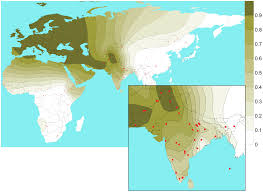PloS子刊:科学家确认SLC24A5基因在南亚人色素沉着多样性中起关
塔尔图大学和英国剑桥大学的研究者带领的一个国际科学家团队对印度当地居民进行了皮肤量色法分析,发现一个重要的色素沉着基因:SLC24A5,这个基因在南亚人中皮肤色素沉着变异中起着关键的作用。相关文章发表于2013年11月07日的《PloS genetics》杂志上。

科学家确认SLC24A5基因在南亚人色素沉着多样性中起关键作用
尽管皮肤色素沉着的遗传学研究已经在过去十年中获得了重大进展,但是涉及到南亚人的研究——是色素沉着多样性的主要研究热点之一,目前仍然处于起始阶段。
科研团队在对对印度当地居民进行了皮肤量色法分析,确认确认SLC24A5基因在南亚人的色素沉着多样性中起着关键的作用。这个浅色皮肤相关基因在印度次大陆广泛分布,其复合模式是由包括选择和人口统计学历史的结合过程而形成的。
通过研究不同组合人群中SLC24A5基因突变的序列,他们指出,在南亚人中的浅色皮肤相关基因跟在欧洲人中发现的基因在血统上是完全相同的。
“我们很有趣地看到,由严格的内婚制进一步形成的区域的、语言的、社会文化边界的效果,构成了南亚遗传多样性的主要支柱,这种效果如此强烈地反映在这个浅色皮肤等位基因的复合模式中,”本文的第一作者、来自爱沙尼亚塔尔图大学的Chandana Basu Mallick解释道。
她进一步补充说,“这项研究能够帮助我们理解,除了紫外线驱动的自然选择之外,其它有助于形成现有的人类肤色生物谱的可能机制,也有助于我们更进一步理解这个复杂的表型性状。”
这项研究的另外一个部分,采用多样化的样本集,利用3730XL DNA Analyzer对SLC24A5进行了重测序,结果帮助我们揭开了一个重要的事实:印第安人分享共同的SLC24A5(引起他们跟欧洲人一样的浅色皮肤的基因)基因的突变,属于相同的单体型背景。
尽管在以前报道的全基因组扫描中,有关SLC24A5中阳性选择的证据,还没有得到很好的证明,但是,南亚人在世界范围内一直未被充分代表的这个事实,却提出了另外一个问题:是否在南亚人中还有这个基因阳性选择的任何证据?令研究者惊讶的是,他们发现,一个不同的选择模式揭示出阳性选择在印度北部而不在印度南部的证据。
“横穿印度的这个浅色皮肤突变的可变存在,表明在自然选择的力量和独特的人口统计学历史和居住在印度次大陆的人口结构之间的一个有趣的相互作用,”这篇论文的联合作者、剑桥大学的Mircea Iliescu说。这项研究也提供了这个基因的合并时间的第一个全面的评估,这对于理解人类浅色皮肤的进化历史至关重要。
原文摘要:
The Light Skin Allele of SLC24A5 in South Asians and Europeans Shares Identity by Descent
Chandana Basu Mallick, Florin Mircea Iliescu, Märt Möls, Sarah Hill, Rakesh Tamang, Gyaneshwer Chaubey, Rie Goto, Simon Y. W. Ho, Irene Gallego Romero, Federica Crivellaro, Georgi Hudjashov, Niraj Rai, Mait Metspalu, C. G. Nicholas Mascie-Taylor, Ramasamy Pitchappan, Lalji Singh, Marta Mirazon-Lahr, Kumarasamy Thangaraj, Richard Villems, Toomas Kivisild
Skin pigmentation is one of the most variable phenotypic traits in humans. A non-synonymous substitution (rs1426654) in the third exon of SLC24A5 accounts for lighter skin in Europeans but not in East Asians. A previous genome-wide association study carried out in a heterogeneous sample of UK immigrants of South Asian descent suggested that this gene also contributes significantly to skin pigmentation variation among South Asians. In the present study, we have quantitatively assessed skin pigmentation for a largely homogeneous cohort of 1228 individuals from the Southern region of the Indian subcontinent. Our data confirm significant association of rs1426654 SNP with skin pigmentation, explaining about 27% of total phenotypic variation in the cohort studied. Our extensive survey of the polymorphism in 1573 individuals from 54 ethnic populations across the Indian subcontinent reveals wide presence of the derived-A allele, although the frequencies vary substantially among populations. We also show that the geospatial pattern of this allele is complex, but most importantly, reflects strong influence of language, geography and demographic history of the populations. Sequencing 11.74 kb of SLC24A5 in 95 individuals worldwide reveals that the rs1426654-A alleles in South Asian and West Eurasian populations are monophyletic and occur on the background of a common haplotype that is characterized by low genetic diversity. We date the coalescence of the light skin associated allele at 22–28 KYA. Both our sequence and genome-wide genotype data confirm that this gene has been a target for positive selection among Europeans. However, the latter also shows additional evidence of selection in populations of the Middle East, Central Asia, Pakistan and North India but not in South India.

